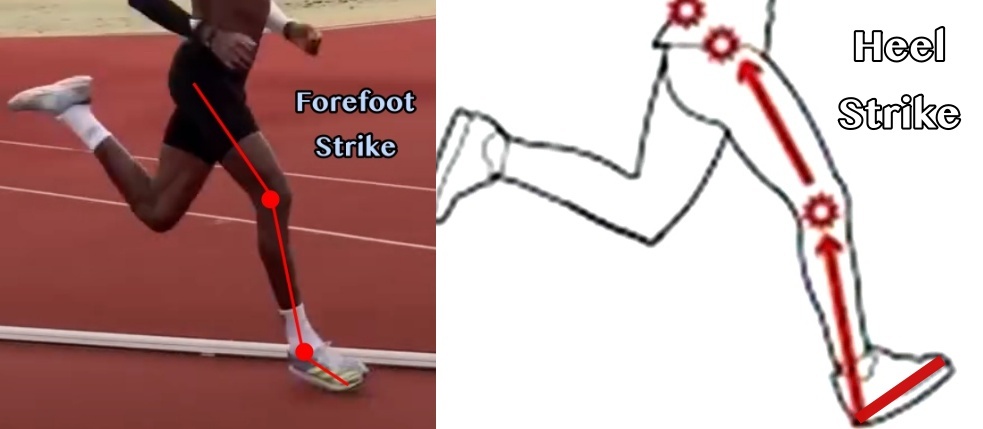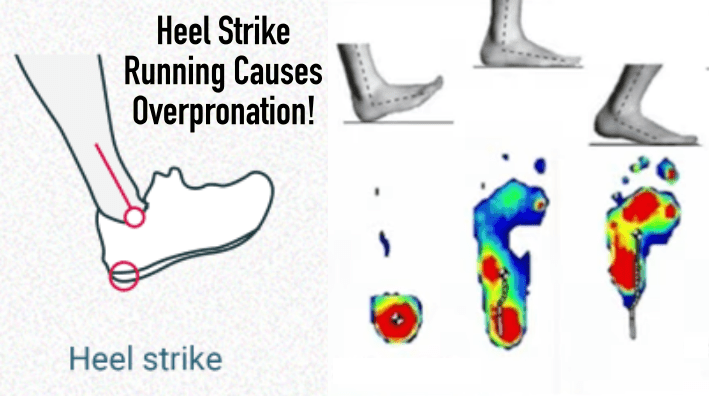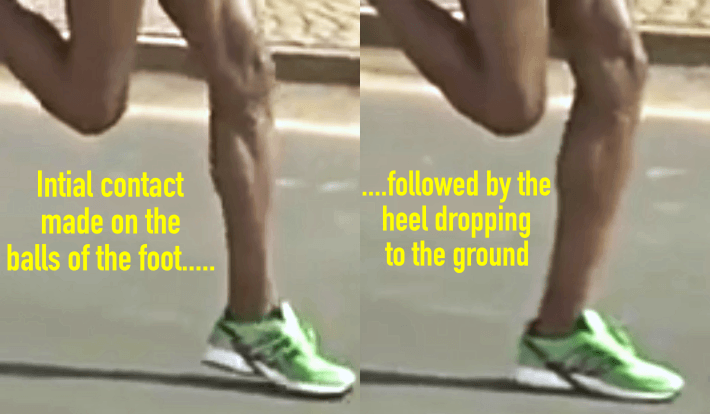One reason for tired feet after running is due to how you’re landing on your foot when running in that you may be heel striking when you should be forefoot striking. This is because in heel strike running, the foot is always over-engaged with the ground in ways that causes the foot to wrestle with the ground too much. This type of straining foot-ground interaction is called ‘over-pronation’, which means the foot is forced into extreme positions, which is always the case in heel strike running, but not in forefoot running, shown below:


Aside from over-taxing the foot by causing more intense movement patterns of the foot, another classic feature of the heel strike running style is the heel-to-toe rollover phase. In this scenario, shown below, after the heel strikes the ground, the foot rolls from heel to toe which causes the foot to make a longer line of travel on the ground, which also allows more time for the foot to alter from its neutral line. At the same time, the foot needs to try harder to correct itself which accounts for pre-mature fatigue of the foot and ankle.

Case in point, new information published in the Journal of Athletic Training uncovered that over-pronation during running fatigued the plantar flexor muscles (muscles lining the top of the foot) whereby over-pronation impaired force transmission through the foot during the stance phase of running, thereby causing the plantar flexors to work harder to maintain running speed.
A similar study in the American Journal of Sports Medicine discovered that when the plantar flexors are tired, they are unable to control pronation, resulting in more pronation and more loading under the medial longitudinal arch. This negative effect is especially true when a heel strike is employed because over-pronation is a proven by-product of heel strike running, not in forefoot running.
As evidence builds showing there are more competing forces acting on the foot in heel strike running, which causes the foot to work too hard to try and correct itself, this is never the case with forefoot running, shown below:

In forefoot running, the foot-ground interaction is the polar opposite to that of heel strike running, whereby as soon as the forefoot (balls of the foot) strikes the ground, the heel quickly drops down to the ground, then the entire foot is quickly removed off the ground. In this way, there isn’t the fatiguing ‘stop and go’ of the foot, like there is in heel strike running, because in forefoot running, ground-contact time is greatly minimized, which is primarily responsible for the reduced risk of over-pronation, foot injury and worn-out feet.
If you’re unsure how to land with a forefoot strike, here’s a YouTube video I did showing exactly how to strike properly on your forefoot and why!
Here are other evidence-backed reasons forefoot running is better than heel strike running by all measures!
References:
[1]. Fourchet et al. High-intensity running and plantar-flexor fatiguability and plantar-pressure distribution in adolescent runners. J Athlet Train, 2015;50(2):117-125
[2]. Weist R, Eils E, Rosenbaum D. The influence of muscle fatigue on electromyogram and plantar pressure patterns as an explanation for the incidence of metatarsal stress fractures. Am J Sports Med. 2004; 32(8):1893–1898.

If you’d like, you can support Run Forefoot and help keep it going by making a donation in any amount of your choosing:

Or, you can support Run Forefoot by shopping at the BEST Barefoot Shoe Brands, and be sure to bookmark these links 🙂
Saguaro: https://www.saguaro.com/?ref=9bVA8fEkmDvB-I
Vibram FiveFingers: https://www.anrdoezrs.net/click-7600968-11372648
Vivobarefoot: https://amzn.to/3vycQOY
Be Lenka: https://www.dpbolvw.net/click-7600968-14330828
Xero Shoes: https://xeroshoes.com/go/Run_Forefoot
Iguaneye: https://www.iguaneye.com/?ref=8tfXVc92
Soft Star Shoes: https://shrsl.com/3mp1b
Wilding Shoes: https://bit.ly/3lIygQP
Bretta Riches
BSc Neurobiology; MSc Biomechanics candidate, ultra minimalist runner & founder of RunForefoot. I was a heel striker, always injured. I was inspired by the great Tirunesh Dibaba to try forefoot running. Now, I'm injury free. This is why I launched Run Forefoot, to advocate the health & performance benefits of forefoot running and to raise awareness on the dangers of heel striking, because the world needs to know.
Latest posts by Bretta Riches (see all)
- Can You Run In Barefoot Shoes? Yes, But DON’T Heel Strike! - 21/07/2024
- Why Cushioned Running Shoes Are Really Bad for Your Feet - 19/07/2024
- Do Cushioned Running Shoes Cause Injuries? - 17/07/2024
